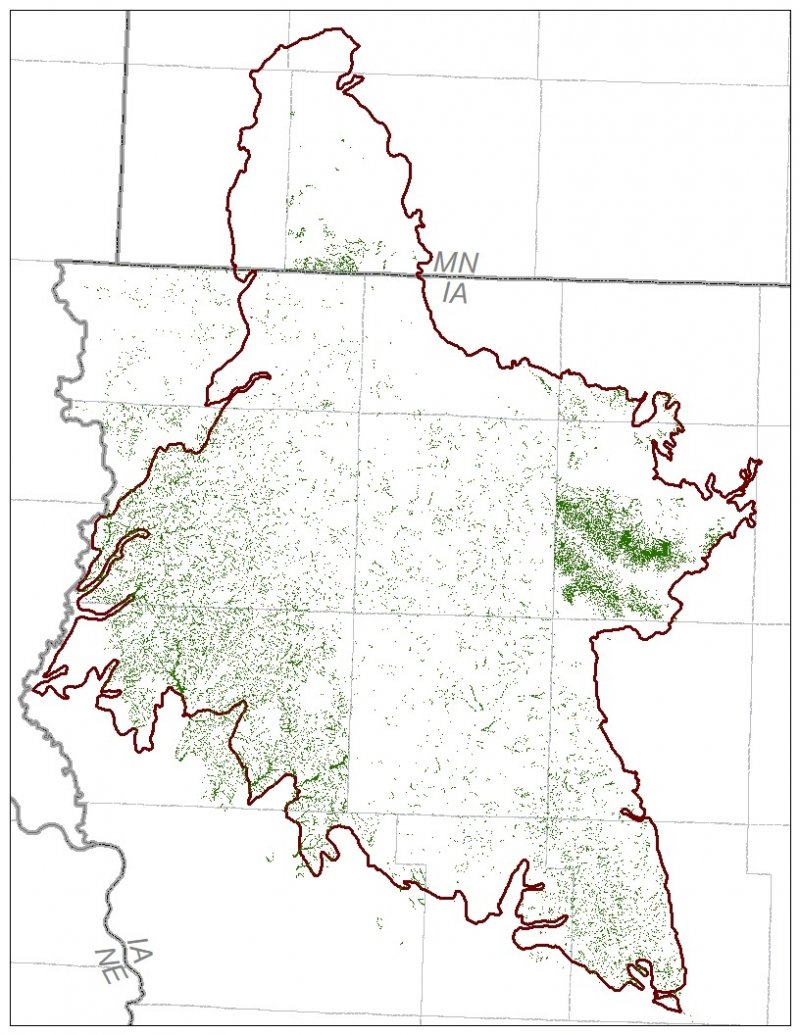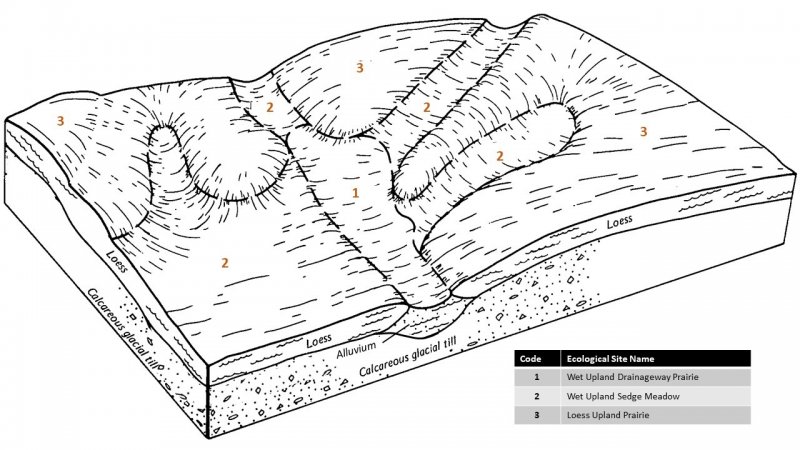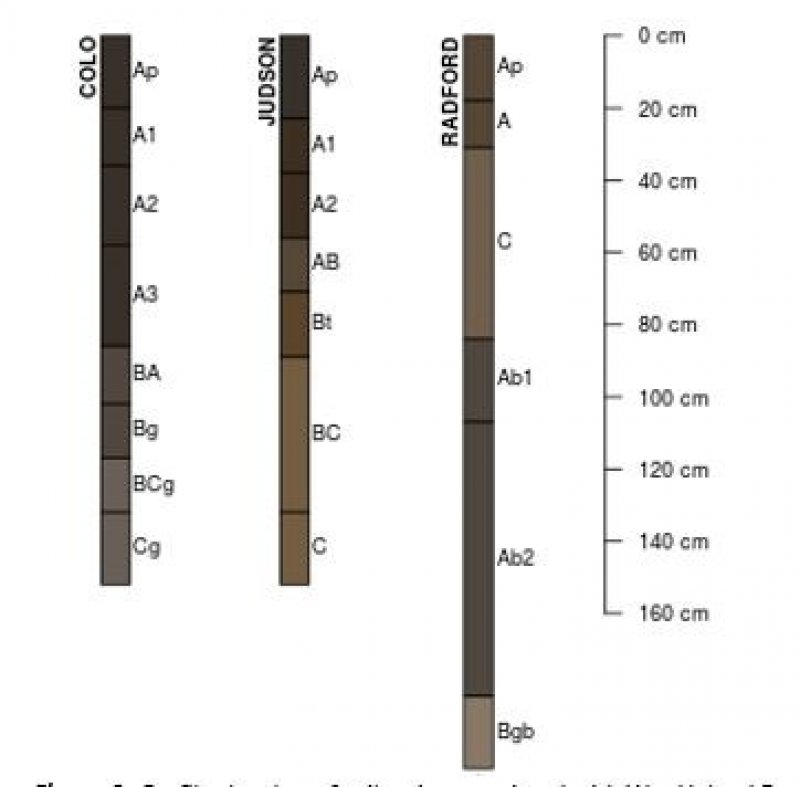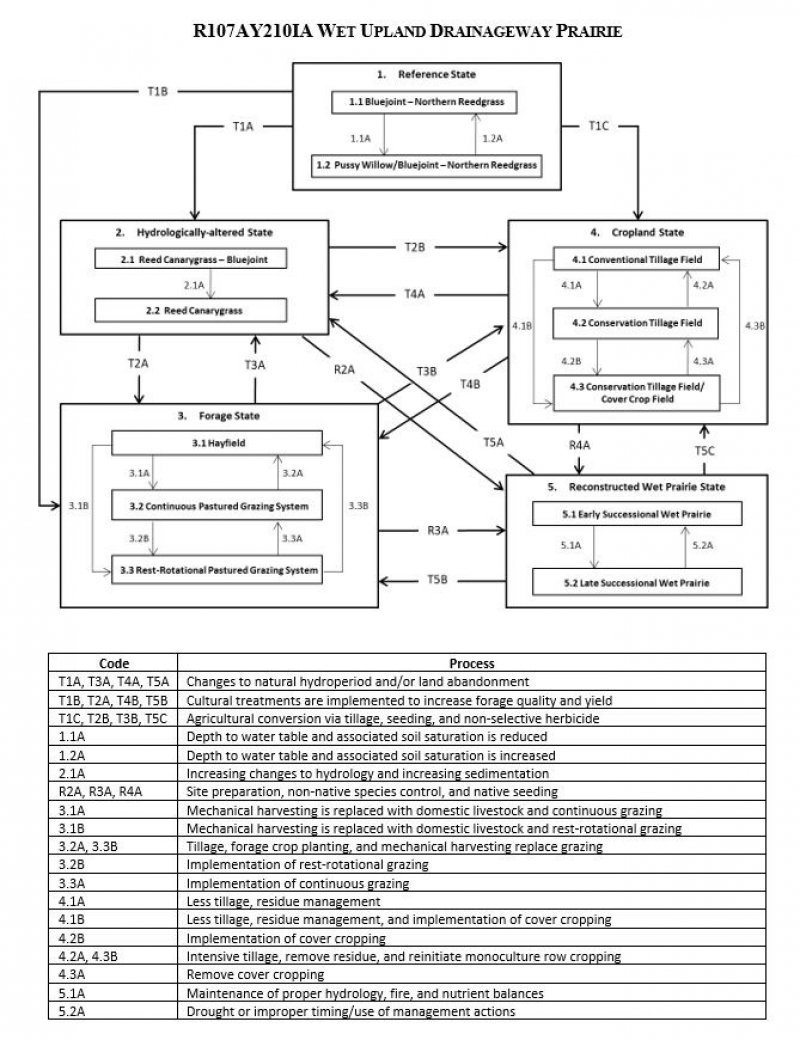Ecological dynamics
The information in this Ecological Site Description, including the state-and-transition model (STM), was developed based on historical data, current field data, professional experience, and a review of the scientific literature. As a result, all possible scenarios or plant species may not be included. Key indicator plant species, disturbances, and ecological processes are described to inform land management decisions.
MLRA 107A is defined by a relatively low relief landscape that experiences lower rainfall amounts and available moisture compared to other MLRAs occurring to the south and east. As a result, prairie vegetation communities dominate the uplands, while forested communities are restricted to medium and large streams (Prior 1991; Eilers and Roosa 1994; MDNR 2017a, b). Wet Upland Drainageway Prairies form an aspect of this vegetative continuum. This ecological site occurs on upland drainageways on poorly to moderately well-drained soils. Species characteristic of this ecological site consist of wet-mesic herbaceous vegetation.
Flooding, fire, and native large mammal grazing are the primary disturbance factors of this ecological site. Periods of brief flooding occur following snowmelt and heavy rains. The water table remains below the rooting zone, but areas of groundwater seepage maintains moist soil conditions (MDNR 2005). Fire intensity typically consisted of periodic, high severity surface fires occurring every 3 to 5 years (LANDFIRE 2009). Ignition sources included summertime lightning strikes from convective storms and bimodal, human ignitions during the spring and fall seasons. Native Americans regularly set fires to improve sight lines for hunting, driving large game, improving grazing and browsing habitat, agricultural clearing, and enhancing vital ethnobotanical plants (Barrett 1980). Bison (Bos bison) and prairie elk (Cervus elaphus) were the main herbivores in northern tallgrass prairies, favoring recently burned patches. Herbivory occurred via mob grazing with large herds of animals rapidly moving across the prairie as they grazed (LANDFIRE 2009). These continuous disturbances provided critical conditions for perpetuating the native prairie ecosystem (MDNR 2005).
Drought has also played a role in shaping this ecological site. The periodic episodes of reduced soil moisture in conjunction with the poorly to moderately well-drained soils have favored the proliferation of plant species tolerant of such conditions. Drought can also slow the growth of plants and result in dieback of certain species. When coupled with fire and herbivory, periods of drought can greatly delay the establishment of woody vegetation (Pyne et al. 1996).
Today, Wet Upland Drainageway Prairies are limited in their extent, having been converted to agricultural production land. Corn (Zea mays L.) and soybeans (Glycine max (L.) Merr.) are the dominant crops grown on this ecological site, but small patches of forage land are present. A return to the historic plant community may not be possible following extensive land modification and significant hydrologic and water quality changes in the watershed, but long-term conservation agriculture or prairie reconstruction efforts can help to restore some biotic diversity and ecological function. The state-and-transition model that follows provides a detailed description of each state, community phase, pathway, and transition. This model is based on available experimental research, field observations, literature reviews, professional consensus, and interpretations.
State 1
Reference State
The reference plant community is categorized as a wet-mesic to wet tallgrass community, dominated by herbaceous vegetation. The two community phases within the reference state are dependent on flooding, fire, and grazing. The inundation and soil saturation associated with brief flooding alter species composition, cover, and extent, while regular fire intervals and native large mammal grazing keep woody species from dominating. Drought has a more localized impact in the reference phases, but does contribute to overall species composition, diversity, cover, and productivity.
Community 1.1
Bluejoint-Northern Reedgrass
Bluejoint – Northern Reedgrass – Sites in this reference community phase represent a fire return interval of approximately every 3 to 5 years. Vegetative cover is continuous (75 to 100 percent) and the tallest plants reach heights greater than 3 feet tall (MDNR 2005; LANDFIRE 2009). Bluejoint, northern reedgrass, prairie cordgrass, and various sedges form the dominant community composition in the lowest portions of the drainageway, but big bluestem (Andropogon gerardii Vitman) and Indiangrass (Sorghastrum nutans (L.) Nash) become important components on the higher portions. Characteristic forbs include Virginia mountainmint (Pycnanthemum virginianum (L.) T. Dur. & B.D. Jacks. ex B.L. Rob. & Fernald), giant goldenrod (Solidago gigantea Aiton), sawtooth sunflower (Helianthus grosseserratus M. Martens), marsh pea (Lathyrus palustris L.), and white panicle aster (Symphyotrichum lanceolatum (Willd.) G.L. Nesom ssp. lanceolatum var. lanceolatum).
Community 1.2
Pussy Wilow/Bluejoint-Northern Reedgrass
Pussy Willow/Bluejoint – Northern Reedgrass – This reference community phase represents the natural plant community succession when fire return intervals extend beyond 5 years. Vegetative cover is still continuous, but the prolonged absence of fire allows sparse shrubs to inhabit the site including pussy willow (Salix discolor Muhl.) and redosier dogwood (Cornus sericea L.) (MDNR 2005).
Pathway 1.1A
Community 1.1 to 1.2
Depth to water table and associated soil saturation is reduced
Pathway 1.2A
Community 1.2 to 1.1
Depth to water table and associated soil saturation is increased
State 2
Hydrologically-altered State
Hydrology is the most important determinant of wetlands and wetland processes. Hydrology modifies and determines the physiochemical environment (i.e., sediments, soil chemistry, water chemistry) which in turn directly affects the vegetation, animals, and microbes (Mitsch and Gosselink 2007). Human activities on landscape hydrology have greatly altered Wet Upland Drainageway Prairies. Alterations such as agricultural tile draining and conversion to cropland on adjacent lands have changed the natural hydroperiod and rate of sedimentation as well as increased nutrient pollution (Mitsch and Gosselink 2007; Eggers and Reed 2015).
Community 2.1
Reed Canarygrass-Bluejoint
Reed Canarygrass – Bluejoint – This community phase represents the early changes to the natural wetland hydroperiod, increasing sedimentation, and unabated nutrient runoff. Native grasses, such as bluejoint, northern reedgrass, and prairie cordgrass, continue to form a component of the herbaceous layer, but the highly invasive reed canarygrass (Phalaris arundinacea L.) co-dominates (Waggy 2010). As reed canarygrass invades, it can not only alter species composition, but vegetation structure as well (Annen et al. 2008).
Community 2.2
Reed Canarygrass
Reed Canarygrass – Sites falling into this community phase have experienced significant sedimentation and nutrient enrichment and are dominated by a monoculture of reed canarygrass (Eggers and Reed 2015). Reed canarygrass stands can significantly alter the physiochemical environment as well as the biotic communities, making the site only suitable to reed canarygrass. These monotypic stands create a positive feedback loop that perpetuates increasing sedimentation, altered hydrology, and dominance by this non-native species, especially in sites affected by nutrient enrichment from agricultural runoff (Vitousek 1995; Bernard and Lauve 1995; Kercher et al. 2007; Waggy 2010; Eggers and Reed 2015).
Pathway 2.1A
Community 2.1 to 2.2
Increasing changes to hydrology and increasing sedimentation
State 3
Forage State
The forage state arises when the site is converted to a farming system that emphasizes domestic livestock production, known as grassland agriculture. Fire suppression, periodic cultural treatments (e.g., clipping, drainage, soil amendment applications, planting new species and/or cultivars, mechanical harvesting) and grazing by domesticated livestock transition and maintain this state (USDA-NRCS 2003). Early settlers seeded non-native species, as smooth brome (Bromus inermis Leyss.) and Kentucky bluegrass (Poa pratensis L.), to help extend the grazing season (Smith 1998). Over time, as lands were continuously harvested or grazed by herds of cattle, these species were able to spread and expand across the prairie ecosystem, reducing the native species diversity and ecological function.
Community 3.1
Hayfield
Hayfield – Sites in this community phase consist of forage plants that are planted and mechanically harvested. Mechanical harvesting removes much of the aboveground biomass and nutrients that feed the soil microorganisms (Franzluebbers et al. 2000; USDA-NRCS 2003). As a result, soil biology is reduced leading to decreases in nutrient uptake by plants, soil organic matter, and soil aggregation. Frequent biomass removal can also reduce the site’s carbon sequestration capacity (Skinner 2008).
Community 3.2
Continuous Pastured Grazing System
This community phase is characterized by continuous grazing where domestic livestock graze a pasture for the entire season. Depending on stocking density, this can result in lower forage quality and productivity, weed invasions, and uneven pasture use. Continuous grazing can also increase the amount of bare ground and erosion and reduce soil organic matter, cation exchange capacity, water-holding capacity, and nutrient availability and retention (Bharati et al. 2002; Leake et al. 2004; Teague et al. 2011). Smooth brome, Kentucky bluegrass, and white clover (Trifolium repens L.) are common pasture species used in this phase. Their tolerance to continuous grazing has allowed these species to dominate, sometimes completely excluding the native vegetation.
Community 3.3
Rest-Rotation Pastured Grazing System
This community phase is characterized by rotational grazing where the pasture has been subdivided into several smaller paddocks. Through the development of a grazing plan, livestock utilize one or a few paddocks, while the remaining area is rested allowing plants to restore vigor and energy reserves, deepen root systems, develop seeds, as well as allow seedling establishment (Undersander et al. 2002; USDA-NRCS 2003). Rest-rotation pastured grazing systems include deferred rotation, rest rotation, high intensity – low frequency, and short duration methods. Vegetation is generally more diverse and can include orchardgrass (Dactylis glomerata L.), timothy (Phleum pretense L.), red clover (Trifolium pratense L.), and alfalfa (Medicago sativa L.). The addition of native prairie species can further bolster plant diversity and, in turn, soil function. This community phase promotes numerous ecosystem benefits including increasing biodiversity, preventing soil erosion, maintaining and enhancing soil quality, sequestering atmospheric carbon, and improving water yield and quality (USDA-NRCS 2003).
Pathway 3.1A
Community 3.1 to 3.2
Mechanical harvesting is replaced with domestic livestock and continuous grazing
Pathway 3.1B
Community 3.1 to 3.3
Mechanical harvesting is replaced with domestic livestock and rest-rotational grazing
Pathway 3.2A
Community 3.2 to 3.1
Tillage, forage crop planting and mechanical harvesting replace grazing
Pathway 3.2B
Community 3.2 to 3.3
Implementation of rest-rotational grazing
Pathway 3.3B
Community 3.3 to 3.1
Tillage, forage crop planting and mechanical harvesting replace grazing
Pathway 3.3A
Community 3.3 to 3.2
Implementation of continuous grazing
State 4
Cropland State
The low topographic relief across the MLRA has resulted in nearly the entire area being converted to agriculture (Eilers and Roosa 1994). Agricultural tile drains used to lower the water table and the continuous use of tillage, row-crop planting, and chemicals (i.e., herbicides, fertilizers, etc.) have effectively eliminated the reference community and many of its natural ecological functions in favor of crop production. Corn and soybeans are the dominant crops for the site, and oats (Avena L.) and alfalfa (Medicago sativa L.) may be rotated periodically. These areas are likely to remain in crop production for the foreseeable future.
Community 4.1
Conventional Tillage Field
Conventional Tillage Field – Sites in this community phase typically consist of monoculture row-cropping maintained by conventional tillage practices. They are cropped in either continuous corn or corn-soybean rotations. The frequent use of deep tillage, low crop diversity, and bare soil conditions during the non-growing season negatively impacts soil health. Under these practices, soil aggregation is reduced or destroyed, soil organic matter is reduced, erosion and runoff are increased, and infiltration is decreased, which can ultimately lead to undesirable changes in the hydrology of the watershed (Tomer et al. 2005).
Community 4.2
Conservation Tillage Field
Conservation Tillage Field – This community phase is characterized by rotational crop production that utilizes various conservation tillage methods to promote soil health and reduce erosion. Conservation tillage methods include strip-till, ridge-till, vertical-till, or no-till planting systems. Strip-till keeps seedbed preparation to narrow bands less than one-third the width of the row where crop residue and soil consolidation are left undisturbed in-between seedbed areas. Strip-till planting may be completed in the fall and nutrient application either occurs simultaneously or at the time of planting. Ridge-till uses specialized equipment to create ridges in the seedbed and vegetative residue is left on the surface in between the ridges. Weeds are controlled with herbicides and/or cultivation, seedbed ridges are rebuilt during cultivation, and soils are left undisturbed from harvest to planting. Vertical-till systems employ machinery that lightly tills the soil and cuts up crop residue, mixing some of the residue into the top few inches of the soil while leaving a large portion on the surface. No-till management is the most conservative, disturbing soils only at the time of planting and fertilizer application. Compared to conventional tillage systems, conservation tillage methods can improve soil ecosystem function by reducing soil erosion, increasing organic matter and water availability, improving water quality, and reducing soil compaction.
Community 4.3
Conservation Tillage with Cover Crop Field
Conservation Tillage with Cover Crop Field – This community phase applies conservation tillage methods as described above as well as adds cover crop practices. Cover crops typically include nitrogen-fixing species (e.g., legumes), small grains (e.g., rye, wheat, oats), or forage covers (e.g., turnips, radishes, rapeseed). The addition of cover crops not only adds plant diversity but also promotes soil health by reducing soil erosion, limiting nitrogen leaching, suppressing weeds, increasing soil organic matter, and improving the overall soil ecosystem. In the case of small grain cover crops, surface cover and water infiltration are increased, while forage covers can be used to graze livestock or support local wildlife. Of the three community phases for this state, this phase promotes the greatest soil sustainability and improves ecological functioning within a cropland system.
Pathway 4.1A
Community 4.1 to 4.2
Less tillage, residue management
Pathway 4.1B
Community 4.1 to 4.3
Less tillage, residue management and implementation of cover cropping
Pathway 4.2A
Community 4.2 to 4.1
Intensive tillage, remove residue and reinitialize monoculture row cropping
Pathway 4.2B
Community 4.2 to 4.3
Implementation of cover cropping
Pathway 4.3B
Community 4.3 to 4.1
Intensive tillage, remove residue and reinitialize monoculture row cropping
Pathway 4.3A
Community 4.3 to 4.2
Remove cover cropping
State 5
Reconstructed Wet Prairie State
Wet prairie habitats provide multiple ecosystem services including flood abatement, water quality improvement, and biodiversity support (Mitsch and Gosselink 2007). However, many wet prairie communities have been eliminated as a result of type conversions to agricultural production, wildfire suppression, changes to the natural hydrologic regime, and invasion of non-native species, thereby significantly reducing these services (Annen et al. 2008). The extensive alterations of lands adjacent to Wet Upland Drainageway Prairies may not allow for restoration back to the historic reference condition. But ecological reconstruction can aim to aid the recovery of degraded, damaged, or destroyed functions. A successful reconstruction will have the ability to structurally and functionally sustain itself, demonstrate resilience to the natural ranges of stress and disturbance, and create and maintain positive biotic and abiotic interactions (SER 2002; Mitsch and Jørgensen 2004).
Community 5.1
Early Successional Wet Prairie
Early Successional Wet Prairie – This community phase represents the early community assembly from wet prairie reconstruction and is highly dependent on invasive species control, hydroperiod repair, planting, and properly timed prescribed fire activities (Adams and Galatowitsch 2006). In addition, adaptive restoration tactics that incorporate multiple restoration methods should be implemented in order to more clearly identify cause-effect relationships of vegetative development (Zedler 2005).
Community 5.2
Late Successional Wet Prairie
Late Successional Wet Prairie – Appropriately timed disturbance regimes (e.g. hydroperiod, prescribed fire, invasive species control) and nutrient management applied to the early successional community phase can help increase the species richness and improve ecosystem function, pushing the site into a late successional community phase over time (Mitsch and Gosselink 2007).
Pathway 5.1A
Community 5.1 to 5.2
Maintenance of proper hydrology, fire, and nutrient balances
Pathway 5.2A
Community 5.2 to 5.1
Drought or improper timing/use of management actions
Transition T1A
State 1 to 2
Changes to natural hydroperiod and/or land abandonment
Transition T1B
State 1 to 3
Cultural treatments are implemented to increase forage quality and yield
Transition T1C
State 1 to 4
Agricultural conversion via tillage, seeding and non-selective herbicides
Transition T2A
State 2 to 3
Cultural treatments are implemented to increase forage quality and yield
Transition T2B
State 2 to 4
Agricultural conversion via tillage, seeding and non-selective herbicide
Transition R2A
State 2 to 5
Site preparation, non-native species control and native seeding
Restoration pathway T3A
State 3 to 2
Changes to natural hydroperiod and/or land abandonment
Transition T3B
State 3 to 4
Agricultural conversion via tillage, seeding and non-selective herbicide
Transition R3A
State 3 to 5
Site preparation, non-native species control and native seeding
Restoration pathway T4A
State 4 to 2
Changes to natural hydroperiod and/or land abandonment
Restoration pathway T4B
State 4 to 3
Cultural treatments are implemented to increase forage quality and yield
Transition R4A
State 4 to 5
Site preparation, non-native species control and native seeding
Restoration pathway T5A
State 5 to 2
Changes to natural hydroperiod and/or land abandonment
Restoration pathway T5B
State 5 to 3
Cultural treatments are implemented to increase forage quality and yield
Restoration pathway T5C
State 5 to 4
Agricultural conversion via tillage, seeding and non-selective herbicide





